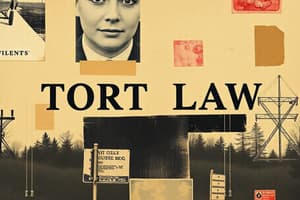Podcast
Questions and Answers
Which of the following is a type of tort that involves deliberate actions causing harm?
Which of the following is a type of tort that involves deliberate actions causing harm?
- Strict Liability
- Intentional Torts (correct)
- Vicarious Liability
- Negligence
Negligence is a type of tort that occurs only in cases of deliberate actions.
Negligence is a type of tort that occurs only in cases of deliberate actions.
False (B)
What are compensatory damages awarded for?
What are compensatory damages awarded for?
Financial compensation for losses suffered by the plaintiff.
In tort law, ______________ refers to the legal obligation to avoid causing harm to others.
In tort law, ______________ refers to the legal obligation to avoid causing harm to others.
Match the type of tort with its description:
Match the type of tort with its description:
Which defense to tort claims implies that the plaintiff agreed to risk?
Which defense to tort claims implies that the plaintiff agreed to risk?
Punitive damages are meant to compensate the plaintiff for their losses.
Punitive damages are meant to compensate the plaintiff for their losses.
What is the term for damages that are intended to punish the wrongdoer?
What is the term for damages that are intended to punish the wrongdoer?
The element of ______________ in negligence establishes a link between the breach and the harm caused.
The element of ______________ in negligence establishes a link between the breach and the harm caused.
Which of the following best describes statutory torts?
Which of the following best describes statutory torts?
Flashcards are hidden until you start studying
Study Notes
Definition of Law of Tort
- A branch of civil law dealing with civil wrongs.
- Provides remedies to individuals harmed by the wrongful actions of others.
Key Concepts
- Tort: An act or omission that causes harm to another, leading to legal liability.
- Types of Torts:
- Intentional Torts: Deliberate actions causing harm (e.g., assault, defamation).
- Negligence: Failure to exercise appropriate care, leading to unintentional harm (e.g., car accidents, medical malpractice).
- Strict Liability: Liability without fault, typically in cases involving inherently dangerous activities.
Elements of Negligence
- Duty of Care: Legal obligation to avoid causing harm.
- Breach of Duty: Failure to meet the standard of care.
- Causation: Link between breach and harm; includes "cause-in-fact" and "proximate cause."
- Damages: Actual harm or loss suffered by the plaintiff.
Defenses to Tort Claims
- Consent: Plaintiff agreed to the risk.
- Comparative Negligence: Plaintiff's negligence contributes to harm, reducing liability.
- Assumption of Risk: Plaintiff knowingly exposed themselves to danger.
Remedies
- Compensatory Damages: Financial compensation for losses (e.g., medical expenses, lost wages).
- Punitive Damages: Additional damages awarded to punish the wrongdoer and deter future misconduct.
- Injunctions: Court orders directing a party to do or refrain from specific actions.
Special Considerations
- vicarious liability: Employer liability for actions of employees performed within the course of employment.
- Statutory torts: Torts created by statute, giving rise to liability beyond common law.
Importance
- Balances individual rights and societal protections.
- Promotes accountability and deterrence of harmful actions.
Law of Tort Definition
- Branch of civil law addressing civil wrongs.
- Provides remedies for individuals harmed by others' wrongful actions.
Key Concepts
- Tort: An act or omission causing harm to another, resulting in legal liability.
Types of Torts
- Intentional Torts: Deliberate actions causing harm, such as assault or defamation.
- Negligence: Failure to exercise appropriate care leading to unintentional harm, such as car accidents or medical malpractice.
- Strict Liability: Liability without fault, typically in scenarios involving inherently dangerous activities.
Elements of Negligence
- Duty of Care: A legal obligation to avoid causing harm.
- Breach of Duty: Failure to meet the expected standard of care.
- Causation: A connection between the breach and the harm, including "cause-in-fact" and "proximate cause".
- Damages: Actual harm or loss suffered by the plaintiff.
Defenses to Tort Claims
- Consent: The plaintiff agreed to the risk involved.
- Comparative Negligence: The plaintiff's negligence contributed to the harm, potentially reducing liability.
- Assumption of Risk: The plaintiff knowingly exposed themselves to danger.
Remedies
- Compensatory Damages: Financial compensation for losses, covering expenses like medical costs and lost wages.
- Punitive Damages: Additional damages awarded to punish the wrongdoer and deter future misconduct.
- Injunctions: Court orders directing a party to perform or refrain from specific actions.
Special Considerations
- Vicarious Liability: Employer liability for the actions of employees performed within the scope of their employment.
- Statutory Torts: Torts established by statute, imposing liability beyond common law.
Importance
- Balances individual rights and societal protections.
- Promotes accountability and discourages harmful actions.
Studying That Suits You
Use AI to generate personalized quizzes and flashcards to suit your learning preferences.



